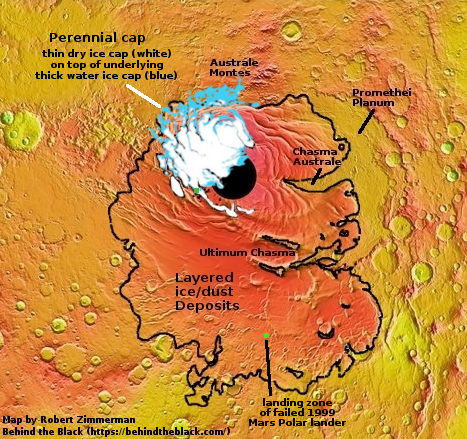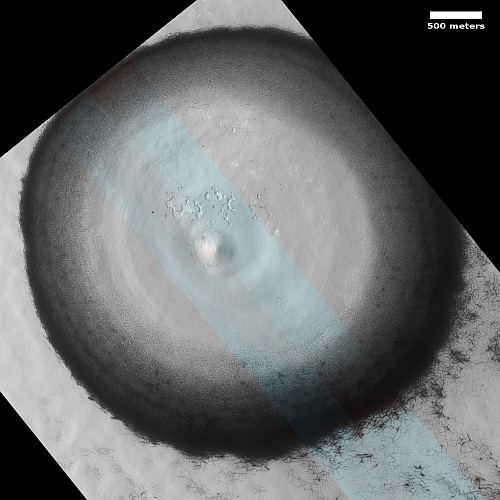Big sink near the Martian south pole
Cool image time! The photo to the right, rotated, cropped, reduced, and sharpened to post here, was taken on September 12, 2022 by the high resolution camera on Mars Reconnaissance Orbiter (MRO). The image is rotated so that south is at the top. The science team labels this a “subsidence feature,” or in plain English, a sinkhole.
Its perfectly circular shape, plus its central peak, strongly suggests we are looking at an impact crater. However, the lack of a raised rim of debris, produced by the ejecta from the impact, raises questions about this conclusion, and is one reason why the scientists think this is a sinkhole instead. Its shape however could be telling us that this sink is simply mirroring the existence of a buried crater.
The overview map below as always provides more context.

The green dot to the left of the south pole marks the location of this sink, sitting on the perennial dry ice cap of the Martian south pole. It sits about 125 miles from the pole.
As indicated by the light blue of the color strip, there is a lot of ice here, either water or dry ice. The small sinks near the center of the big sink also suggest ice. Since this location is on the thin dry ice cap, the sink suggests we are seeing the sublimation of dry ice to reveal the water ice cap below, caused for some reason by the existence of a buried ancient impact crater.
The shape of the small sinks inside this big sinkhole provide further confirmation of this hypothesis, as they are reminiscent of the sublimation of dry ice found at other places on the dry ice cap, such as what scientists had dubbed the Happy Face Crater.
On Christmas Eve 1968 three Americans became the first humans to visit another world. What they did to celebrate was unexpected and profound, and will be remembered throughout all human history. Genesis: the Story of Apollo 8, Robert Zimmerman's classic history of humanity's first journey to another world, tells that story, and it is now available as both an ebook and an audiobook, both with a foreword by Valerie Anders and a new introduction by Robert Zimmerman.
The print edition can be purchased at Amazon or from any other book seller. If you want an autographed copy the price is $60 for the hardback and $45 for the paperback, plus $8 shipping for each. Go here for purchasing details. The ebook is available everywhere for $5.99 (before discount) at amazon, or direct from my ebook publisher, ebookit. If you buy it from ebookit you don't support the big tech companies and the author gets a bigger cut much sooner.
The audiobook is also available at all these vendors, and is also free with a 30-day trial membership to Audible.
"Not simply about one mission, [Genesis] is also the history of America's quest for the moon... Zimmerman has done a masterful job of tying disparate events together into a solid account of one of America's greatest human triumphs."--San Antonio Express-News
Cool image time! The photo to the right, rotated, cropped, reduced, and sharpened to post here, was taken on September 12, 2022 by the high resolution camera on Mars Reconnaissance Orbiter (MRO). The image is rotated so that south is at the top. The science team labels this a “subsidence feature,” or in plain English, a sinkhole.
Its perfectly circular shape, plus its central peak, strongly suggests we are looking at an impact crater. However, the lack of a raised rim of debris, produced by the ejecta from the impact, raises questions about this conclusion, and is one reason why the scientists think this is a sinkhole instead. Its shape however could be telling us that this sink is simply mirroring the existence of a buried crater.
The overview map below as always provides more context.

The green dot to the left of the south pole marks the location of this sink, sitting on the perennial dry ice cap of the Martian south pole. It sits about 125 miles from the pole.
As indicated by the light blue of the color strip, there is a lot of ice here, either water or dry ice. The small sinks near the center of the big sink also suggest ice. Since this location is on the thin dry ice cap, the sink suggests we are seeing the sublimation of dry ice to reveal the water ice cap below, caused for some reason by the existence of a buried ancient impact crater.
The shape of the small sinks inside this big sinkhole provide further confirmation of this hypothesis, as they are reminiscent of the sublimation of dry ice found at other places on the dry ice cap, such as what scientists had dubbed the Happy Face Crater.
On Christmas Eve 1968 three Americans became the first humans to visit another world. What they did to celebrate was unexpected and profound, and will be remembered throughout all human history. Genesis: the Story of Apollo 8, Robert Zimmerman's classic history of humanity's first journey to another world, tells that story, and it is now available as both an ebook and an audiobook, both with a foreword by Valerie Anders and a new introduction by Robert Zimmerman.
The print edition can be purchased at Amazon or from any other book seller. If you want an autographed copy the price is $60 for the hardback and $45 for the paperback, plus $8 shipping for each. Go here for purchasing details. The ebook is available everywhere for $5.99 (before discount) at amazon, or direct from my ebook publisher, ebookit. If you buy it from ebookit you don't support the big tech companies and the author gets a bigger cut much sooner.
The audiobook is also available at all these vendors, and is also free with a 30-day trial membership to Audible.
"Not simply about one mission, [Genesis] is also the history of America's quest for the moon... Zimmerman has done a masterful job of tying disparate events together into a solid account of one of America's greatest human triumphs."--San Antonio Express-News



Since its at a pole it could also be winds helping it form to into a nice circle.